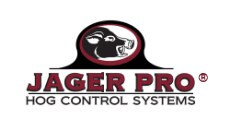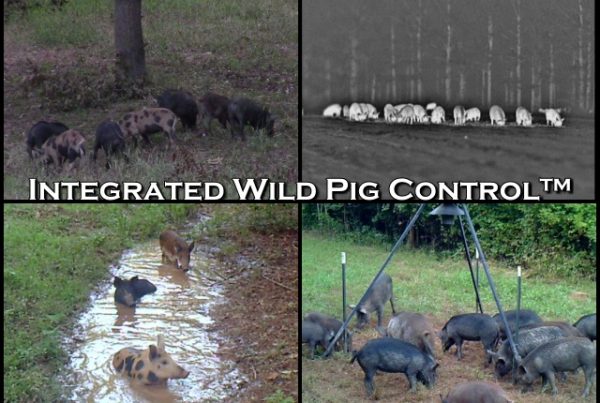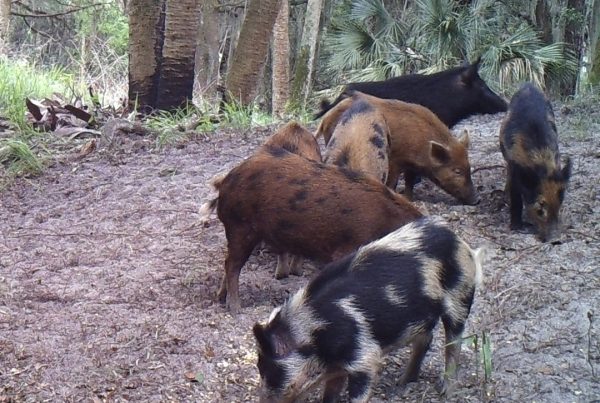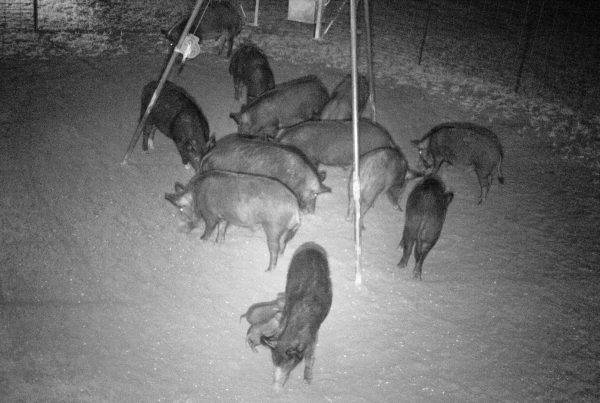The key to achieving Integrated Wild Pig Control® (IWPC®) performance standards is to incorporate a process whereas the population dynamics and education level of each individual sounder dictates the time between each step. This information is based on photo and video observations from the bait site.
There are three important steps to properly implement our Capture Success Matrix®:
1. Condition wild pigs to trust the bait site as a daily food source
2. Condition wild pigs to trust the corral enclosure as a daily food source
3. Implement the optimum trigger device for 100% capture of the entire sounder
Step 1 – Condition Wild Pigs to Trust the Bait Site as a Daily Food Source
Each bait site should be fitted with an I.C.E.® camera to provide immediate reconnaissance photos to a cell phone, iPad or computer. All feeders should also include a trail camera since video footage produces more detailed intel than photos alone. The goal is to quickly determine the total number of sounders, total population of pigs within each sounder and number of adults vs. juveniles per sounder. Mount cameras at the target area at least six feet above ground level using a T-post and T-post camera mount to ensure the camera has the correct angle to trigger the PIR motion sensor with the camera infrared illuminators positioned above the target area and out of a pig’s normal line of sight.
Feeders must reliably dispense a daily food source at the same time and quantity. If not, pigs could travel to an alternate food source and may not return to the bait site. Unconditioned pigs will appear nervous and tend to exit the bait site several times for no apparent reason. Conditioned pigs will appear more relaxed and tend to stay at the location until the bait is consumed. Conditioned pigs are often observed bedded or even nursing at the bait site.
Regularly review video camera footage to determine if the bait amount is correct. The goal is for the entire sounder to arrive when the feeder spins and quickly consume all bait within 15-20 minutes. Excessive baiting is expensive and conditions pigs to be lazy and feed randomly. Providing the correct amount of bait creates a sense of urgency for the entire sounder to eat immediately when the feeder spins. Creating this competition for food becomes a strategic advantage during the next step when conditioning the same pigs to trust the corral enclosure as a daily food source. This strategy will also reduce the number of non-target species feeding at the bait site as there will be no food available for the next 23 hours.
Wild pigs rarely leave an established bait site unless they become pressured from an outside source such as sport hunting, running dogs, night shooting or timber cutting. Seasonal agricultural practices and mild winters can cause man-made and natural food sources to be more abundant causing direct competition with bait sites. Abnormal weather patterns may also disturb daily routines. Heavy rains can make swollen creek and stream crossing difficult for piglets. Drought conditions can force unexpected travel to seek new water sources. Large, aggressive boars can claim a bait site and prevent entire sounders from feeding. Young gilts or sows with very small piglets may not risk feeding near dominate boars. Sows giving birth to a new litter will usually stay close to their nest and may not visit the feeder or travel with the sounder for six to ten days. The closer the bait site is to her nesting area the sooner she may return to the feeder with her new litter.
Controlling as many of these outside pressures as possible will reduce the number of days necessary to accomplish this task. Step #1 has been accomplished when the entire sounder(s) has fed multiple nights in a row and are conditioned to trust the individual bait site as a daily food source. Only then will land managers have gathered enough intel needed to select the most efficient method, technology or trap size to “accomplish 100% sounder removal using the least amount of fuel, time and labor.”
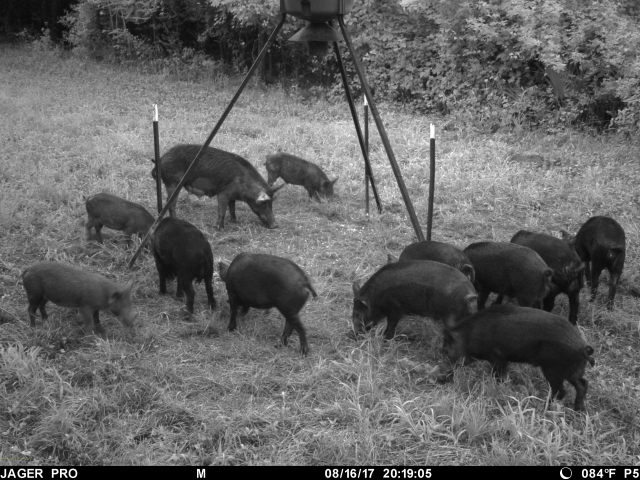
Capture Success Matrix – Step #1
Step 2 – Condition Wild Pigs to Trust the Corral Enclosure as a Daily Food Source
Camera intel from step one already established the total number of sounders, individual sounder populations and juvenile-to-adult ratios. The mission now shifts from simply recording the data to actually planning and implementing the tasks necessary to efficiently kill or capture every pig on the property. The population dynamics and education level of each individual sounder will dictate the time needed to condition each sounder to trust the corral enclosure as a daily food source.
Keep all bait inside the trap enclosure. Only reward pigs with food if they cross the gate threshold. Typically, higher juvenile ratios equate to quicker captures. Most piglets and sub-adults enter the trap enclosure during the first 24-hours. Adult sows may observe their offspring feeding inside the trap for several days (nights) before trusting the enclosure enough to enter themselves. The IWPC® standard is to immediately capitalize on their mistake the first time it happens to limit additional fuel, time and labor costs. Also, trap resistant pigs may not give land managers a second chance for success.
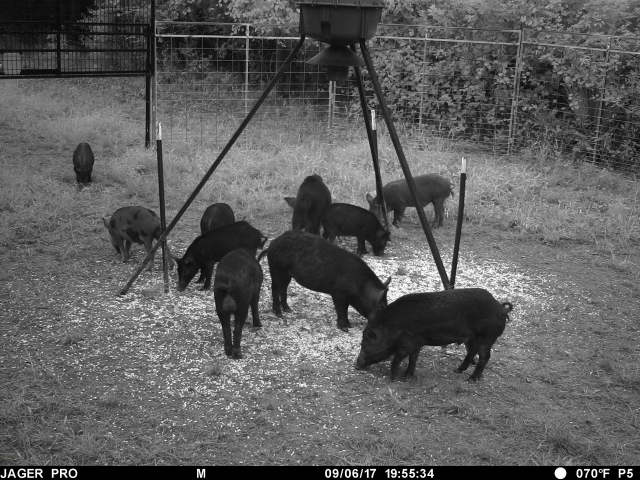
Capture Success Matrix – Step #2
Step 3 – Implement the Optimum Trigger Device
The final step is to Implement the Optimum Trigger Device for 100% capture of the entire sounder. Our Verizon and AT&T wireless cellular cameras with data plans send intel photos or video to any cellular device when the PIR motion sensor detects movement at the target location. Cameras are positioned opposite the trap gate to properly view pigs still outside the enclosure.
Remote control technology allows users to send text commands via a mobile app back to the camera to trigger the M.I.N.E.® Gate closed from their home or office. This equipment saves fuel, time and labor allowing 24-hour surveillance without wasting daily travel time and expenses to multiple bait sites. A person makes an educated decision to close the gate when the entire sounder is counted inside the enclosure via texted photo while the user is offsite in another location. This approach can achieve whole-sounder removal in less than six days at most bait sites. The trap enclosure is left in the same location only if there was a second sounder at the feeder before erecting the trap enclosure.
Another option is the onsite remote-control transmitter which will send a wireless signal 250-yards to the control box receiver for immediate gate closures. This trigger device is best utilized when the land manager desires to visually observe pigs at the trap enclosure and trigger the M.I.N.E.® Gate closed from an Observation Post (OP) located downwind. This tactical position allows observation and capture of large sounders using binoculars during the day and infrared optics at night to trigger the M.I.N.E.® Gate closed using the onsite transmitter. Another vital use of the OP is to shoot a trap resistant adult who avoided the enclosure when the sounder was captured. This strategic location should take advantage of the natural contour of the land and seasonal wind direction. The OP can be a box blind, tree stand, permanent stand or farm machinery.
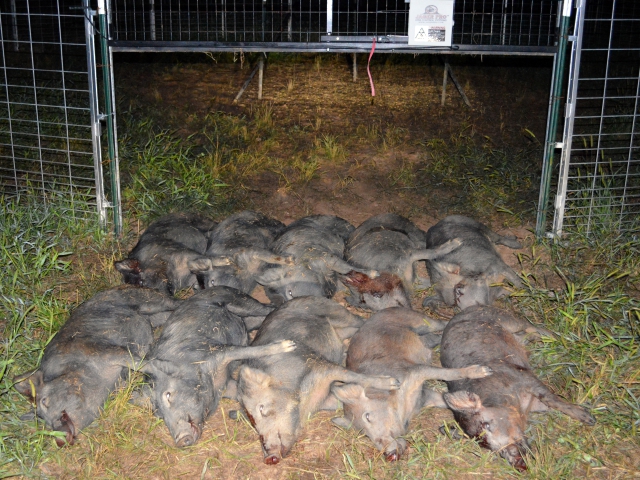
Capture Success Matrix – Step #3
